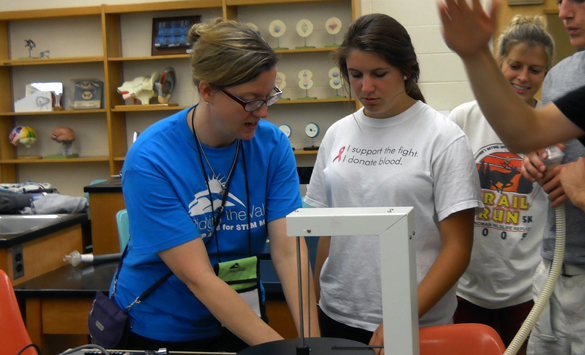HARRISONBURG, VA. – The feeding patterns of indigenous clams, human respiration, measurements and robotics were just some of the topics covered during the 2011 Summer Bridge Program at Eastern Mennonite University (EMU).
“We try to expose students to the core majors we provide and let them experience what each has to offer,” said Roman Miller, PhD, EMU professor of biology.
The Summer Bridge Program (SBP), June 25 – July 16, allows students from Blue Ridge Community College, Bridgewater College, EMU and James Madison University to experience all fields of Science, Technology, Engineering and Mathematics (STEM). EMU became a part of the program thanks to a grant from the National Science Foundation.
“The students attend a morning math session at Blue Ridge Community College before traveling to a specific college for that week,” added Miller. “They interact with their peers and instructors while getting acquainted with each campus on a week-to-week basis.”
The three-week program features field trips, educational seminars and recreational activities in addition to working in the classroom. Students are able to earn college credit hours upon completion.
Studying and Problem Solving
The 50 students that attended this year’s program were grouped into “organic cells,” or subgroups, and spent a day with an instructor in their field of expertise.
Jim Yoder, PhD, EMU professor of biology, gave a discourse on the difference in size and feeding rates of indigenous clams to Asian clams – an invasive species found locally in Virginia. Students analyzed the digestive rates and graphed their results to formulate a conclusion.
“Working with live clams, graphing the data and seeing their internal structure makes for an interesting lab,” said Yoder.
EMU professor of physics Leah Boyer, PhD, and professor of biology, Greta Ann Herin, PhD, had their respective classes work with alternate forms of measurement. Boyer instructed her class on calculating the rate of projectiles, using geometry to figure the angle and pitch of an object.
Herin’s class measured respiratory capacity – breathing rate while resting, holding their breath or following an exercise.
“Students automatically come with judgments as to what is good or bad and what is viewed as healthy or not,” said Herin. “These exercises demonstrate to the students what a huge capacity the human body has and how we are designed to move.”
Down the hall, robotics took center stage as EMU professors of computer sciences Dee Weikle, PhD, and Charles Cooley taught an experimental lab in writing programmable code. The code relayed from a computer to a robotic car, giving the car a command to turn or accelerate.
“Problem solving skills and building connections between the students was one of the focuses of this lab,” said Cooley. “We wanted them to gain exposure to all aspects of STEM related fields and have fun in the process.”
Growth in the Program
“The program has experienced continued growth in the three years that we’ve been apart of it,” said Miller. “We have seen an increase in students who want to attend EMU and become STEM majors.”
Of the students that attended this year’s program, 10 were registered to attend EMU in the fall.
“Our numbers and the quality of student that we bring in continue to climb throughout the time we’ve been involved,” said Miller.
Herin agreed, adding, “the students that are coming to EMU continue to stand out from their peers due to their skills and knowledge in each field.”
Future Summer Bridge Programs
The National Science Foundation, in partnership with the four area colleges, announced a two-year extension on the grant that allowed EMU to be included in the Summer Bridge Program.
“This cross-institutional collaboration has not happened in 20 or more years,” said Miller. “Bob Kolvoord and JMU were big factors in inviting EMU to participate in this program and making this work.”
The extension and the prospect of future EMU students being involved in the program will continue to pay dividends to the university, says Miller.
“The program has been a huge recruiting tool and it benefits the incoming class of students who built relationships with professors and have a grasp on what it takes to be a STEM major at EMU.”
